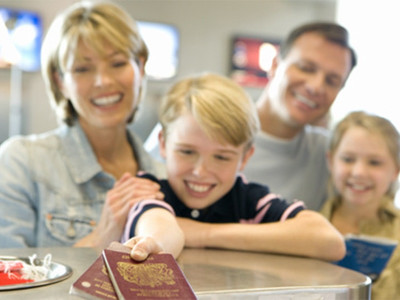Updated on 08.09.2023
Are you planning to travel to the USA with children for tourism or business reasons? Find out which visa options are available for families, what family-friendly visa requirements there are and what you need to bear in mind when applying.
Share article:

A trip to the United States is a long-held dream for many families. The vibrant cities, breathtaking natural wonders and abundance of family activities make the USA a desirable destination for parents and their children. But before the suitcase can be packed and the tickets booked, there is one important hurdle to overcome: the visa requirements for a trip to the USA with children.
From the necessary documents, to advice on visas, to practical tips, we will provide you with all the information you need to make your travel preparations easier and get your American adventure off to a smooth start.
In most cases of US visa applications, the children's visa goes through the parents, as a so-called derivative visa. So with all US Work Visas but also for Students (F-1) or J-1 (Trainee) Visas.
That is, for example, if a parent receives a L-1 work visa, children up to the age of 21 may obtain an L-2 visa upon application. The same applies to H-Visa (H-4 for children) or O visa (O-3 for children). As a rule, these visas for accompanying children are issued for the same term as the parent's visa. However, it is possible, as for example with the E-Visa (E-1/E-2) may vary due to different nationalities.
Note: Please note that it is not possible to Adopted and foster children other rules exist.
If the children reach the US age of majority, you must either change nonimmigrant status, i.e., apply for another/your own visa, or leave the country.
Typically, these (derivative) visas can be used to attend a public/private educational institution in the US. Employment is only rarely possible for older children on these visas (e.g. J-2 visa) and under strict conditions.
If you want to enter the country as a tourist, your child, depending on his or her nationality and the length of stay, will either need a B-2 tourist visa or may even be eligible for a visa-free entry (Visa Waiver Program/ESTA) enter the USA. No kind of derivative visa exists here.
Or you are planning for your child to attend school in the U.S. on their own, in which case a separate F-1 or J-1 visa may apply.
It is important to note that the exact requirements and procedures for each visa are different. Early planning is critical to selecting the right visa option for your family and completing the application process in a timely manner.

Applying for "child" visas for a trip to the USA can be a challenging task that requires thorough preparation. Here are some tips and tricks that can help you navigate the process of Visa application smoothly for your children:
Early planning
Start planning the visa application for your children early. Find out about the required documents, deadlines and procedures in order to have enough time to prepare and send the application documents.
Complete documentation
Make sure you prepare all required documents completely and correctly. This includes passports, birth certificates, photographs, forms, and other supporting documentation. Check the requirements on the official U.S. Embassy or Consulate website to make sure you don't miss anything. Proof of custody or notarized letters of verification from the other (e.g. divorced or separated) parent may also need to be provided.
Consistent information
Make sure that all the information you provide on the application forms is consistent. It is imperative that names, dates of birth, and other personal information be consistent on all documents. Inconsistencies could result in delays or rejections.

Prepare interview
Just as with adults, children 14 years of age and older officially have a Interview at the US Consulate required if a U.S. visa is needed. In most cases, the parents applying for a visa are at the consulate with their children, so that there are only isolated queries about the children. However, a joint, personal visit is not mandatory, so there may also be constellations in which the child attends an independent appointment. However, there is no guarantee that you will be allowed to accompany your child to the consulate, as officially only the applicants themselves are allowed to enter the consulate for security reasons. On the day of the appointment, politely ask the security staff at the entrance and have your own passport ready.
Prepare your child for the interview by explaining why they want to travel to the U.S. and what they plan to do there. Practice possible questions to help them answer confidently and clearly. Most interviews at the U.S. Consulate are conducted in English, but many of the officers speak German (albeit limited) or the local language of the consular location.
A consular appointment may take a few hours to complete, the Interview itself usually takes only a few minutes.
Make appointments early: Make an appointment at the U.S. Embassy or Consulate as early as possible to submit the application. Waiting times can vary greatly depending on location and can still be several weeks in some cases. However, for certain visa categories, postal submission is currently possible - even for children over 14 years of age.
Careful preparation and early planning are key to ensuring that your children get the visas they need and that your trip goes off without a hitch.
When it comes to international travel with children, a valid passport is an indispensable document. The previous children's passport was abolished at the end of 2023 and replaced by the regular passport, which has a shortened validity period of six years for people under the age of 24.
A regular passport can of course also be issued for children. It contains more pages than the former children's passport and offers space for additional entry stamps. More importantly, however, it is biometric or electronically readable (ePassport). This is particularly important for travel to countries such as the USA, as a biometric passport is mandatory for visa-free entry under the Visa Waiver Program (ESTA).
If you discover shortly before departure that your child does not have a valid passport, you can alternatively apply for an express passport, which is issued within a few days - not to be confused with a temporary passport.
A regular, biometric passport is always required to enter the USA under the Visa Waiver Program (ESTA) and to apply for a US visa. If a temporary passport is used instead, a US visa must be applied for. All US visas issued are biometric or electronically readable and therefore replace the missing ePassport standard of a temporary passport.
Planning a trip to the USA with children can be an exciting but challenging task. From choosing destinations to organizing accommodation and activities, there are many aspects that need to be considered to ensure that the trip is stress-free for the whole family.
When traveling with your child, it is advisable to carry a copy of the child's passport and visa, as well as other important documents such as a copy of the birth certificate. This will make it easier to prove the child's identity and age, if necessary. Or, for example, the formalities in case of loss of a travel document.
Also keep in mind that you may need proof of custody arrangements or consent forms from the other parent at the border. For children under 18 traveling alone, a notarized parental consent form is generally required upon entry into the U.S.

Learn about applicable safety and health measures in the U.S. and follow the appropriate regulations. Remember to purchase travel insurance that covers medical care and other unforeseen events. Your German health insurance may offer a foreign plan for this purpose or, in some cases, travel protection may be available through some credit card providers.
Planning well in advance will allow you to enjoy the trip and create unforgettable memories with your children.
Date:
Wir und unsere Partner nutzen Cookies, um personenbezogene Daten wie z.B. Browsing-Daten zu speichern und abzurufen, um z.B. Inhalte und Werbung bereitzustellen und zu personalisieren sowie die Verwendung der Website zu analysieren und das Benutzererlebnis zu verbessern. Sie erfahren mehr über die Zwecke, für welche wir und unsere Partner Cookies einsetzen, wenn Sie unten auf den Button „Cookie Einstellungen“ klicken. Hier können sämtliche Einstellungen auch geändert werden. Nachträglich kann man jederzeit seine Cookie-Auswahl überdenken oder seine Einwilligung widerrufen, indem man auf den Link zu den Cookie-Einstellungen im Footer unserer Webseite klickt. Beachten Sie bitte, dass das Blockieren einiger Cookie-Typen unsere Möglichkeiten zur Bereitstellung von auf Ihre Interessen zugeschnittenen Inhalten haben kann oder einige Funktionen der Webseite nur eingeschränkt zur Verfügung stehen.
Durch klicken auf “Alle Cookies akzeptieren” stimmen Sie unserer Nutzung und der Weitergabe Ihrer Daten an unsere Partner zu.